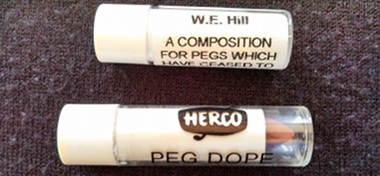Master Hand Violin Shop
Store Hours
Owner
Elizabeth Ecklund
Elizabeth Ecklund
It happens to everybody. You wake up one morning (usually in the spring), and when you try to tune your violin or cello, the pegs won't budge. "That's odd", you think, since the pegs turned fine just yesterday. Maybe your hands are too sore from something you did the day before? No, it's not you; your instrument is demonstrating to you that it knows the weather has changed. And, unfortunately, the pegs are not the only part of the instrument affected by humidity changes. However, for each negative effect, there are ways to counteract your instrument's bad behavior.
One of the most obvious signs of acute humidity change is that pegs become either too tight or too loose (this is assuming the pegs fit properly). As temperature and humidity rise, the wood of the pegbox begins to swell ever so slightly. The added moisture to the wood causes the pegbox to hug the pegs, and they stick in place. Conversely, as the temperature and humidity decrease, the wood dries out slightly and loosens its hold on the pegs. The result is that it can seem impossible to get pegs to stick. What can you do about tight and loose pegs? You can use peg dope! Paradoxically, this lipstick-like compound can both lubricate and add friction to the peg/pegbox juncture. To use peg dope, you must remove the peg and apply dope to the peg on the regions that contact the peg box. You can dope by yourself, if you have peg dope, or you can have us do it for you. (In emergency cases, you can temporarily use chalk or powdered rosin when the pegs are slipping.)

While peg changes may be the first sign of humidity changes, they are not the most serious. As weather gets drier, the glue holding the violin together can dry out, and the spruce on the top of the violin can lose enough moisture to the point where the wood pulls apart and cracks begin to form. Top cracks due to decreased humidity are especially common near the saddle; the ebony does not dry out and shrink as much as the surrounding spruce, so the saddle pushes the wood apart. We have seen instruments where the entire top came crashing off because the seams' glue had all dried out in the winter, and we have seen unchecked top cracks that have extended over the soundpost. Fortunately, seam openings and top cracks do not seriously devalue the instrument when caught early. And while we enjoy making money fixing your instrument, we still believe prevention is the best method. This is why we recommend that every instrument be maintained in a house that is humidified. If you do not have humidifier on the heater, then you can use an instrument humidifier instead. The long, green, snake-like rubber devices will keep your instrument from excessive drying.
In addition to causing cracks, humidity changes can make the strings become hard to play. As an instrument swells with moisture in the summer, the spruce top will rise. The bridge will be elevated while the fingerboard is not, and the strings can be raised too far above the fingerboard for you to easily push the strings down. Conversely, as the humidity decreases, the spruce top of the instrument will lower as it dries, and the bridge may sink too low. With the strings too close to the fingerboard, the player will be unable to make distinct notes. This symptom is particularly common in cellos and basses. If you have severe problems with your bridge moving, the best solution is to keep two bridges: a winter and a summer bridge.
There are many other minor displays of humidity that can occur around your case; your rosin can become too sticky, your gut strings may die a sudden death, etc. To a large degree, humidity changes just happen and must be dealt with as they come and minimized when possible. To minimize changes, it is in your best interest to leave your instrument in a relatively controlled enviroment (ie, a temperature controlled building). Instruments do not do well when subjected to sudden, extreme changes, such as being left in over-heated or freezing cars while you go out for dinner. Extreme changes are a great way to damage your instrument. Humidity changes happen, but fortunately, the damages due to them can be minimized by being aware of potential problems.
Share on Facebook